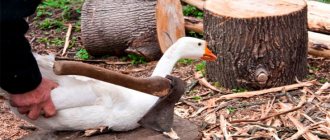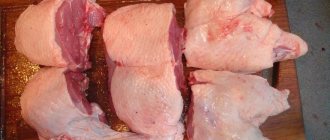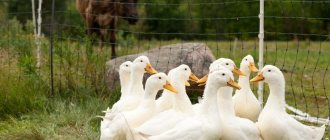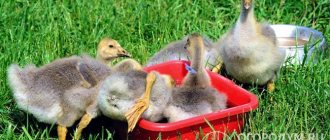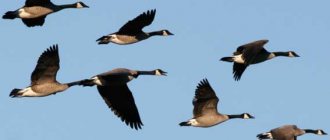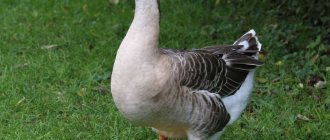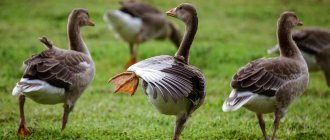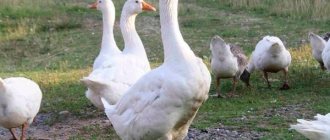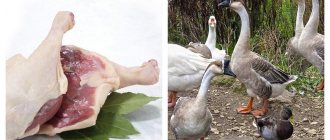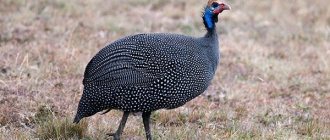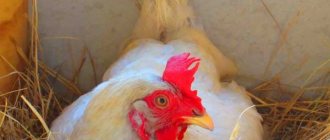Goose meat is always in great demand. Poultry farms, whose main activity is raising geese, are engaged in breeding not only for individual consumption, but also for mass sale. Raising geese for meat is considered to be the most profitable and popular direction in poultry farming. The profitability of the business is due to the unpretentiousness of birds in keeping, as well as the peculiarities of feeding. In addition to dietary meat, you can get feathers and down from geese, as well as such a valuable food product - liver. To prevent the taste of the carcass from deteriorating, it is important to know how to properly slaughter geese for meat and at what age it is best to do this.
Basic rules for preparing poultry for slaughter
The bird is not fed for about 12 hours before slaughter. During this period, the goose's crop and digestive tract are freed from food. This makes gutting and cutting the carcass easier.
Important! If it is necessary to obtain down and feathers from a bird, a few days before slaughter the geese are transferred to clean bedding.
They put a large basin and a bathing trough for walking, and drive the herd to the pond.
In the old days, they began to kill geese after snow fell. Ganders and geese are not afraid of the cold; the bird happily bathes in clean snow, cleaning its feathers.
Preparation of a winter diet
In the winter, long-necked animals are fed exclusively on high-calorie foods. The feed ration is made taking into account the need to maintain the productivity of geese and maintain the activity of ganders.
In winter, feeding geese is reduced to two times
In winter, birds are fed twice a day, in the morning the feeders are filled with wet mash, in the evening - with dry food. They begin to feed the livestock three times a day only towards the end of January.
All mash consumed by the birds is heated, dry food is first brought into a warm room for several hours, potatoes and beets, which geese love so much, are also heated before distribution to feeders.
When to chop geese?
To obtain meat, goose is chopped starting at the age of 4 months. The exact period depends on the breed of bird and its feeding method.
Simple village domestic geese raised on grass, with a minimal addition of grain, will reach slaughter weight no earlier than six months.
Meat breeds (Italian White, Linda, Leggart) are quite precocious. With the addition of feed to the grass diet, geese are slaughtered as early as 4 months.
If it is necessary to obtain fluff from the carcass, the timing is adjusted depending on the molting period. Before the age of 4 months, the goose is not slaughtered: the bird has not finished its first molt.
By this age, young animals completely replace baby down with adult feathers and get rid of stumps - growing feathers on the body.
Advice! According to culinary experts, the most delicious, juicy meat is the carcass of a goose at the age of 7-8 months. By this age, the bird produces “mature” meat, as well as a large liver.
How much should it weigh?
Early ripening meat specimens reach a weight of 4-5 kg by 4 months. Freed from the entrails, legs, head and feathers, the carcass will weigh 2.5-3 kg.
Be sure to read:
What to feed geese so that they gain weight quickly?
Useful tips
Pay attention to the differences in the diet of pets at different stages of cultivation. If in the summer they ate food of plant origin, then by autumn it was time to gain weight and accumulate fat. Since September, birds are less often allowed out for walks, and their diet should be based on wet mash, which is prepared from steamed feed with small boiled potatoes, grated beets and other ingredients. When the herd is mature and pets are in sight all day, you need to select individuals with leadership qualities to produce offspring in the future. The gander must be an authoritative leader and have the characteristic features of the breed.
As for the slaughter of poultry, after finishing the procedure it is important to leave the carcass so that all the blood can drain out. Otherwise, you risk spoiling the meat - reducing its shelf life or making it unfit for consumption. Blood flows out in a period of 5 to 20 minutes. When slaughtering, it is important to know the anatomy of the bird, use sharpened tools, and perform all manipulations quickly and accurately.
Slaughtering technique
There are several ways to slaughter large birds. The traditional method of slaughter by cutting off the head with an ax is not suitable for the goose.
The bird is heavy and strong; holding a goose in one hand is impossible and can lead to injury. In goose farming, other methods are used.
Internal method
For this type of slaughter, you need to stock up on sharp scissors with long blades. To begin with, the bird is tied up and hung upside down.
To prevent the goose from beating its wings, it is placed in a metal cone with a hole for the head in the narrow part. You can use a regular bag by cutting off a corner.
Sequencing:
- With one hand, open the beak and insert scissors into the mouth, pointing the tip towards the back wall of the skull.
- They quickly cut the veins and pierce the palate, plunging the scissors into the brain.
- Allow the blood to drain from the carcass. Plucking begins after 20-30 minutes.
At first glance, the method is complicated, but after a little practice it is convenient and fast.
External method
The bird is secured in the same way as described above, head down. The throat under the beak is cut with a sharp knife. The incision is made deep, down to the vertebrae. To facilitate blood flow, the head is immediately separated.
In villages they practice cutting geese on the ground using a knife. The carver presses the bird to the ground, stands on its wings, not allowing the goose to move.
With one hand he holds the head and forces the goose to stretch its neck, and quickly cuts its throat with a knife. The bird is immediately lifted onto a hanger or placed in a pre-dug groove in the ground with an angle to allow the blood to drain.
Rules for feeding fighting cocks
A good basis for the diet for fighting roosters can be mixed feed, which must be selected based on their age. This nutritional mixture, which is available in granules or loose form, contains all the necessary nutrients, vitamins and microelements, so birds quickly gain weight on it, grow strong, healthy and strong.
When raising chickens and roosters for meat or to obtain eggs, feed is not always used, since grain, vegetable waste, herbs and other feed options are much cheaper and their use is more profitable. However, when keeping fighting cocks, such savings on the diet are no longer practical.
Since fighting roosters have an increased need for proteins and vitamins, in addition to feed they should be given:
- boiled eggs;
- cottage cheese, yogurt and other dairy products;
- meat;
- finely chopped green onions or other greens, sprouted grains.
Also suitable for fighting cocks are other foods that are used when raising almost any bird:
- different types of grain;
- vegetables;
- earthworms and so on.
To ensure that the roosters are in the best possible physical shape, they can be given semi-roasted meat before the fight.
With proper feeding, roosters will quickly gain weight, and the likelihood of developing diseases will decrease. They will also be able to effectively fertilize a large number of chickens. A properly selected diet is one of the foundations of success, which will allow you to achieve good results with minimal costs when keeping and breeding poultry.
Very often it is necessary to fatten cockerels separated from hens at a time when it is already possible to determine the sex based on secondary characteristics. If the cockerels are not left in the reproductive flock or only the strongest are used, then the rest are put into fattening. In this case, of course, it is impossible to achieve any exceptional gains, since when separated from chickens, cockerels of egg-laying breeds are only 6 weeks old, and cockerels of meat-laying breeds are 10-12 weeks old. We are talking about improving the quality of meat.
Plucking a goose
After draining the blood from the carcass, plucking begins. To protect the down and feathers from contamination with blood residues, the end of the goose's neck is tightly tied with a rope.
There are two methods of plucking: dry and wet. The first option is used to collect fluff and feathers, which immediately after plucking can be sorted and put into further processing.
Using the wet method (after scalding the carcass with boiling water) cleans the goose much easier and faster.
Dry method
The goose is plucked dry no later than half an hour after slaughter, while the carcass is still warm. The bird is placed on a table or lap and work begins, first removing the largest feathers from the wings and tail.
Be sure to read:
Meat breeds of geese, 10 largest and most profitable for breeding
Pull out the feather as it grows with sharp movements.
Scalding or wet method
At the time of slaughter, large basins or troughs and wooden sticks are prepared for turning the carcass over. The water is heated to a temperature of +80…+85 degrees.
The goose is immersed in hot water so that the water completely covers it. Leave the carcass in the water for 5-7 minutes, turning it over with chopsticks to thoroughly wet the fluff.
Then the bird is taken out of the basin, placed on the table and plucked until the carcass has cooled.
A variation on the theme of “wet” plucking – steam treatment:
- They make a fire. Place a basin or wide bucket of water on the fire.
- When the water boils, place a wire rack on the vessel and place a goose carcass on it.
- Keep the goose over the steam for several minutes on each side.
- Start plucking. Hot steam makes it easier to separate feathers and down without making them too damp.
Some goose owners have adapted steam irons (steamers) to make plucking easier. The tool is used to process part of the carcass, pluck it, and move on to the next section.
If you have a large number of geese, it makes sense to purchase a feather plucking machine.
The unit can be made at home from an old washing machine.
Centrifugal feather removal machine
Feather and down processing
The collected fluff and feathers are sorted, removing dirt. The wet feather is dried at temperatures up to +70 degrees for 40-50 hours, spread out in a thin layer on wire racks or coarse cloth.
You can dry it at room temperature, but the process will take longer. Periodically there is fluff, the feather is stirred.
Freezing the fluff is practiced if the slaughter was carried out in winter. Raw materials in gauze bags are hung outside, under a canopy. Excess moisture from the feather is frozen out.
Before storage, down is separated from large feathers. Store products in cloth bags in dry rooms.
Fattening of young animals
The goslings begin to feed as soon as they move into the brooder. The sooner the babies begin to eat properly, the faster the yolk sac dissolves and the stronger the bird grows.
Usually, complementary feeding begins with a hard-boiled chicken egg or yolk diluted in water. Next, cottage cheese, porridge, greens, and table scraps are introduced. Everything seems to be fine, the gosling is growing. But this is not enough for rapid weight gain.
It is in the first days that the foundation for the future productivity of any farm poultry is laid - during this period the diet should be as balanced as possible
A balanced diet involves an optimal balance of energy value, proteins, fats, carbohydrates, minerals and amino acids. The standards for goslings when fattening for meat, recommended by Professor of Agricultural Sciences E. E. Epimakhova, are given in the table:
| Index | Age (weeks) | |
| 1-4 | 5 and older | |
| Calorie content | 290 | 300 |
| Crude protein | 20 | 16 |
| Crude fiber | 4 | 4,5 |
| Lysine | 1 | 0,94 |
| Methionine | 0,5 | 0,41 |
| Ca | 0,75 | 0,75 |
| P | 0,65 | 0,6 |
| Na | 0,2 | 0,2 |
To form muscle mass, first of all you need to pay attention to proteins and amino acids in the diet of babies. Calorie content is no less important. Its deficiency will lead to weight loss, and its excess will lead to obesity. In addition to feeding, we must not forget about the living conditions of the babies. The room for them should be warm and clean.
Mesh flooring is an excellent solution when raising goslings for meat.
During the first 3 days, maximum feed conversion is observed, which begins to decrease from the 4th day of life of the chicks. With an intensive type of fattening, the optimal weight for a purebred meat bird is achieved by the age of 9-10 weeks. Further growing reduces profitability. With this type of fattening, E. E. Epimakhova recommends limiting the activity of young animals as much as possible, ensuring cage or floor housing in small rooms without walking, which will subsequently negatively affect the health of geese older than 10 weeks. At this point, the weight of the bird reaches, and often exceeds, 4 kg.
With longer maintenance, weight gain indicators will begin to decrease significantly, the death of individual individuals is possible, and the cost of meat will increase significantly.
Important: poultry fed for meat from the first days of life cannot subsequently be used for breeding!
In the first three days, experts advise preparing a starter feed mixture consisting of:
| Name | Content, % |
| Corn | 80 |
| Barley | 10 |
| Peas | 5 |
| Herbal meal | 3 |
| Powdered milk | 2 |
Goslings must be provided with food and water ad libitum, without restrictions.
The starting mixture is given both dry and in the form of wet mash. The grain must be crushed , free from shells.
You can use oats instead of barley.
If desired, peas can be replaced with soybeans, milk powder with skimmed milk, but then it is necessary to use cake to increase the amount of fat.
If babies have problems with feathers, then methionine is added to the diet.
Once a week, it is recommended that instead of plain water, pour a weak, no more than 0.3% solution of table salt (not iodized!) into the drinking bowls. This helps the chicks clear their beaks of stuck food.
Important: goslings do not tolerate sudden changes in feed very well. New additives should be introduced gradually, replacing 10-15% of the main feed with them.
Of the industrial feeds, specialized ones are used: PK-34 (1-4 weeks) and PK-34-1 (from 5 weeks).
Approximate consumption rates of mixed feed and balanced homemade dry feed mixtures are presented in the table:
| Age, days | Consumption, g per head per day |
| 1-5 | 35 |
| 6-10 | 90 |
| 11-20 | 110 |
| 21-30 | 220 |
| 31-40 | 280 |
| 41-50 | 328 |
| 51-60 | 338 |
It is necessary to strictly monitor the microclimate in the room with goslings. A decrease in temperature is reflected in the expenditure of energy to warm the body; in addition, outbreaks of diseases are possible, which also negatively affect growth. Too high a temperature causes lethargy and extreme thirst in young animals, which leads to a decrease in food consumption.
Feed babies every 2-3 hours, but at least 7 times a day
To increase the volume of feed consumed, do not turn off the light in the brooder for the first 5-10 days. Next, the duration of daylight is gradually reduced to 14 hours and feeding is reduced to 4-5 times a day.
singeing
To remove all small hairs and fluffs from the goose skin, the carcass must be singed. This is done over a fire, gas stove or using a hand-held gas burner.
Be sure to read:
Raising geese at home for beginners: breeding and maintenance
The carcass is brought close to the fire at such a distance that it shrinks from the heat, but does not bubble. After holding the goose over the fire a couple of times, the charred hairs are wiped off the skin with a clean rag.
To give the carcass a presentation, lightly sprinkle it with flour, then wipe it with a dry cloth.
Poultry house
Year-round breeding of geese is impossible without a convenient poultry house. Birds should feel comfortable and live in safety. For each adult you need to have 1 sq. m area. Crowding and darkness cause egg pecking and feather loss. The site for the poultry house is chosen to be dry and level.
When building an enclosure:
- Wood should be preferred.
- The inner surface of the wall should be smooth and easy to clean.
- The walls and ceiling are whitewashed.
- The roof is insulated.
- The windows should be quite large and reinforced for safety.
- A solarium for walking is being built.
- Places for feeding and drinking water are provided. The water in the drinking bowls must be fresh and in sufficient quantities.
- Ash baths are installed in the enclosure or solarium, bathing in which destroys parasites.
- The number of nests is constructed in accordance with the number of females: one nest for two individuals.
Geese tolerate cold well, but the temperature should not fall below +5°. There should be no drafts in the goose house, because geese cannot stand them.
An exhaust hood is required to maintain moisture levels. Natural light is not enough; electricity is a must. The lamps are suspended at a height of 2 m, 60 W per 6 sq. m. m. Lighting should be moderate and uniform.
Geese need a walk. If there is no body of water nearby, install a container of water for swimming.
Butchering the carcass
Butchering begins by removing the rope from the bird's neck and squeezing out any remaining blood.
Further actions:
- The paws are cut off at the joint with a knife. The wings are trimmed with poultry scissors along the elbow crease.
- From the cloaca upward, an incision is made into the skin and abdominal wall with a sharp knife. The length of the incision is up to 10 cm. You must act carefully so as not to catch the intestines.
- The hand is inserted into the incision and, moving it in a circle, the internal organs are separated from the carcass. The cloaca is cut out with a circular motion of the knife.
- Holding the stomach, carefully remove the tripe through an incision in the abdomen. Remove the lungs and the cackling tube from the carcass if it remains in the neck.
- The heart and liver are separated from the tripe, not forgetting to separate and discard the bile.
- The inside of the carcass is blotted with clean rags and put away for a day or two in a cool place (temperature about +3 degrees) for maturation. The goose can then be frozen.
Attention! Do not wash meat with water before storing!
How to butcher a carcass
Cutting must be carried out with extreme caution, as this can lead to a deterioration in the taste of the meat and the appearance of the carcass. To carry out the procedure, do the following:
- Before starting the manipulation, make sure the mascara is clean. It cannot have feathers or down. It is permissible to remove dirt manually or with tweezers.
- Remove the bird's head. To do this, make an incision in the skin in the area of the second vertebra.
- Cut off the wings in the area of the bend of the elbow and the paw in the joint area. These areas are the easiest to cut. Such fragments are prohibited from being used for cooking.
- Start dissecting the organs. First of all, it is recommended to remove the esophagus and trachea. To do this, you need to cut the stomach. It is also permissible to pull out these organs through the cloaca. If difficulties arise, you can use a knife.
- To open the abdomen you need to take a sharp knife. In this case, you should start from the cloaca and move down to the keel. The incision should be made carefully so as not to affect the internal organs and intestines.
- Remove the giblets and other internal organs. The stomach and liver are usually used for food.
- Remove the cackling tube with a knife.
- Rinse the carcass well and leave for 2 hours. She should lie in room conditions. After this time has passed, the meat can be frozen.
At what age can you slaughter a turkey?
Poultry can be slaughtered when its weight reaches at least 12 kg; it is usually necessary to rear the birds for up to eight to nine months. If you have a meat breed of turkey, then broilers require less growing time; they are ready for slaughter at four months of age, sometimes six months.
Interesting materials:
How to make a selection from a list in a cell in Excel? How to make a grid visible in Excel? How to make only one name on Facebook? How to make a scale of 100 in Photoshop? How to make eyebrows in Photoshop? How to center an image in Photoshop? How to make a picture brighter and more contrast in Photoshop? How to make a multi-page PDF in Photoshop? How to make multiple artboards in Photoshop? How to make multiple pages in one PDF file in Photoshop?
How many eggs does a goose lay?
Egg laying in geese is a seasonal process, and, despite exceptions, most often it is in the spring; in general, it occurs for five months of the year. Geese lay the most eggs before 8 a.m. (60%), although they can lay eggs until 6 p.m., but much less frequently. With a productivity of 30 eggs, the female can lay 1 egg at the end of February, 12 in March, 10 in April and 7 in May. But the number of eggs per month may vary between breeds:
- Toulouse brings 100 eggs in the first year, 140 in the second, and 120 eggs in the third;
- Kholmogorskaya - in the first year - 100, in the second - 125, in the third - 160 pieces;
- Romenskaya - in the first year - 100, in the second - 125, in the third - 162 eggs.
There are breeds of geese in which egg production reaches its peak in the fifth year of life.
Despite the fact that geese live for about 20 years and use females for about 6 years, keeping such birds as laying hens for longer is considered inappropriate, since their egg production begins to decline. If we take the average productivity of a bird as 50 eggs per year, then during this period it can produce about 300 eggs. It is clear that in more prolific breeds this number is much larger - up to 900 pieces or more.
Geese eggs have a white shell and their weight ranges from 120 to 200 g. They can have two or three yolks.
